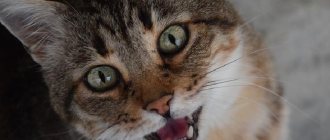When a pet has babies, this is an important event not only for her, but also for the owners. The birth of kittens requires careful attention to the animal and can lead to complications that are dangerous for the mother and babies. In the event of an unforeseen situation, in order to help your pet, you need to understand what is happening and know exactly what help is required. You need to know whether a cat can give birth to one kitten, what to do if not all babies were born, and much more.
How many kittens does a cat normally give birth to for the first time?
For owners who keep a cat, the question of the number of kittens is important, because they need to be placed in good hands. The size of the litter depends on the conditions in which the animal exists. If they are favorable, then experience shows that on average 4-6 kittens are born. Deviations do happen, but they are rare.
A pregnant pet requires close attention from the owner
For your information! In very rare cases, lambing can reach 10-15 individuals, but such situations are the exception.
Frequent cat pregnancy
- Will Mura come out?
Since the birth of one kitten embryo requires one egg (from the mother cat) and one sperm (from the father cat), the number of embryos depends on how many mature eggs will be fertilized. If, say, five eggs have matured in a cat’s body, and all have been fertilized, then in a couple of months five lovely kittens will be born.
The trick is that not all eggs mature at the same time (!), and therefore several cats can take part in their fertilization. In this case, the kittens will be from different fathers. It will probably be a little difficult to figure out the genes here - some from mom, some from dad, but which one?
A little medicine. Estrus is the stage of a cat's reproductive cycle during which ovulation occurs (the release of an egg from the ovary into the abdominal cavity). A mature egg is capable of fertilization within 12-48 hours. Sperm can exist inside the female's body for 4-5 days. It is characteristic that ovulation in a cat occurs after mating, which serves as a stimulus for the release of eggs. On average, the number of eggs varies from 3 to 7. It is all these numbers that make it possible for several eggs to be fertilized by different sperm during one ovulation period (i.e. one estrus).
But that is not all!
How to understand how many kittens a cat has in the womb
Sometimes you can guess the number of newborns by counting the number of nipples in the mother cat. Subtract two from it and get the most probable lambing value.
How many kittens can a cat give birth to?
This issue can be approached taking into account the physiological characteristics of the animal. The size of the offspring is determined by the number of places on the walls of the uterus where maturing eggs are attached.
Note! There is an observation that stray animals are more fertile compared to domestic ones.
To determine the number of future offspring, you can feel the belly of a pregnant cat. This can only be done by an experienced specialist, because there is a risk of harm to the fruit. Palpation is carried out 20-21 days after mating. Later, the abdomen fills with amniotic fluid and it becomes impossible to determine the size of lambing. This procedure can also be performed on days 49-55.
The most accurate method is ultrasound examination, which is carried out starting 21 days after mating.
A veterinarian can help you find out about the number of future kittens.
Could it be that a cat gave birth to one kitten?
Sometimes after birth only one kitten appears. Owners usually know that the normal number is 4-6 newborns and fear that others are left dead inside. It is important to know whether this situation is normal or not, because if something goes wrong, the cat needs human help.
Reasons why only one kitten is born
How long can a cat live without food and water?
Can a cat have one kitten? Veterinarians believe that this situation is quite possible and does not indicate a health problem in the pet. This could be influenced by the following factors:
- the cat gives birth for the first time at too young an age;
- when the birth occurs in old age, the appearance of only one kitten is natural;
- the number of eggs fertilized during mating can be random. Sometimes there may be only one;
- If the cat is not completely healthy, he may have problems with semen production.
Note! Sometimes the reasons are due to the fact that the fetuses began to grow, and then dissolved, and only one kitten was born. A situation where some eggs fail to attach to the wall of the uterus can lead to the same result.
What you need to know when adopting a cat from a shelter
1 Are vaccinations necessary?
A domestic cat needs to get a comprehensive vaccination against viruses and rabies once a year. Even if the cat is at home, where everything is clean, he can get sick: some kind of dirt can be brought on the sole of a shoe and thus infect the animal. So, in order to protect it, it is better to vaccinate the cat annually and treat it against parasites.
2 How to prepare your family and home
It is imperative to make sure that all family members are okay with having a pet in the house. The apartment must be completely safe for the cat to live in (nets are placed on the windows, wires or objects that could injure the animal are hidden). It is advisable to purchase a tray, scratching post, filler, and food in advance. We will tell you directly at the shelter which food is best to buy for the chosen cat. We feed our pets only worthy premium food and guide future owners towards this. We are always in touch with the owners of our graduates and regularly advise them on issues of caring for animals. You can contact us for advice any time after you have adopted a pet.
Why a cat may not give birth to all kittens at once
At what age can a cat become pregnant for the first time?
Can a cat still have a kitten in her stomach after giving birth? This situation is quite possible due to the following reasons:
- young or too old age of mother;
- poor health or serious illness in your pet;
- hormonal state of the body;
- insufficient care during pregnancy and childbirth;
- diet.
Other reasons are also possible. The condition of the animal in the last week is especially important. Stress and fear are undesirable and pose a danger to both the cat and her babies.
Before giving birth, the cat must be protected from stress, otherwise it may not give birth.
Do cats miss their kittens?
Contents hide
Do cats miss their kittens?
Many cat owners describe something similar. Especially those who, by hook or by crook, are accustomed to “getting rid of” unwanted offspring. Let's leave aside the ethical side of the issue; someday we will talk about this too. Or another, more typical situation: sooner or later, grown-up kittens are placed in “good hands.” The cat's behavior often changes; she begins to feel sad, rush about, and desperately look for her babies. Let's think: is the cat really worried or are we, as always, thinking of something, endowing our pets with non-existent human qualities?
The first weeks of life. Kittens, as soon as they are born, are completely dependent on their mother. As you know, they are born completely blind and can’t do anything. Therefore, the first lessons of survival in our big world are taught to them by their mother cat! She also teaches children hygiene and self-care skills. But kittens grow up very quickly and begin to live their own lives. And this happens many orders of magnitude faster than with us humans. Some of our “offspring” are essentially children even at twenty years old!
But let's return to kittens: at the age of three weeks, a kitten is already beginning to actively explore the world around it. At four weeks, the kitten receives its first hunting lessons - it learns to get its own food. At about the same age (or a little later), the kitten tries solid food for the first time.
The beginning of adult life. At the age of 10-12 weeks, kittens can no longer be called foolish babies: they are ready to find their new home and start living independently. This, however, is what happens: the kittens are housed by this time. How does a cat's behavior change? Many owners notice that their pets look confused and meow pitifully, looking for their grown and “fledged” babies. The picture is more than sad... But there is good news: the cat usually grieves for a couple of days, sometimes a little more, and then returns to “normal” life.
Let's not blame the mother cat for being too callous. There is already something of us, human, in this. From the point of view of the animal world, everything is absolutely normal and natural. And it is also natural that cats do not feel any melancholy towards their kittens, given into “strange” hands.
Do cats recognize their matured cubs after some time? Here's another interesting fact: what happens if an adult offspring is brought back together with its natural mother? Will animals be imbued with related feelings? Alas and ah: they will not be imbued with it. When a mother and her babies live together, in one box, they are united by a common unique aroma. When the “kids” go to different houses, the “common” smell quickly disappears. So, if you suddenly decide to take your pet to the “parent’s house”, then he will experience nothing but stress: strange, unfamiliar smells await him. And a completely alien cat, even though it’s her own mother!
For sentimental people, this is rather sad news. No intensity of passions, reunited families... Let's leave these dramas to the scriptwriters of television series for housewives. And every cloud has a silver lining: the cat quickly recovers from the consequences of “mental trauma” and simply enjoys life with its owners, in its own home.
Photo: pixabay.com
Signs of unfinished labor
Before taking action, you need to check whether the cat can give birth to not all kittens at once. The situation can be found out by observing it. Signs that not all kittens have been born include the following:
- Mom lies on her side without changing position. There is little or no interest in children;
- the cat does not want to eat or drink;
- when observing an animal, you can periodically see how attempts occur;
- if you carefully palpate the tummy, you can feel a strong muscle tone;
- the mother has had a fever for a long time;
- Blood discharge is noticed from the uterus, during which an unpleasant odor can be felt.
Important! If there is an assumption that not all babies were born, it is necessary to call a specialist as soon as possible and send the cat to a veterinary clinic. In such cases, an ultrasound examination is performed to clarify the clinical picture and measures are taken according to the situation.
Bleeding may mean labor is not over
The main signs of the end of labor
When a cat gives birth, it is important to make sure everything is successful in the end. This can be judged by the presence of the following signs:
- As soon as the mother realizes that all the kittens are out, she begins to actively care for the offspring, feeding them milk. At the same time, the cat intensively licks the babies, feeds them, purrs;
- If you listen to your breathing, you will find that it is even. Heart beats and pulse are rhythmic and follow at a normal speed;
- Mom eats and drinks with pleasure;
- the pet is able to get up and walk at least a little;
- when labor ends, if palpation is done no earlier than 40 minutes later, the abdomen will feel soft and relaxed to the touch. When palpating, you cannot feel the presence of seals. The muscles may be tense for a short period of time, but this quickly passes.
An indirect sign of a favorable end of labor may be the natural and calm behavior of the pet. However, it is normal for some cats to remain calm even when giving birth.
What to do if the cat cannot give birth to the last baby
If the cat did not give birth to all the babies, then it is necessary to provide her with all possible help. Otherwise, the last baby may die inside and thereby provoke the death of the mother.
It is important to know whether a cat can give birth within a few days of each other. Typically, the period between the appearance of kittens is 15 minutes. up to two hours. In rare cases there may be exceptions.
First of all, you need to understand what happened. It is not recommended to feel the cat's belly. Inexperienced people will not be able to find out anything definite in this way, but will easily harm both the fetus and the mother. You need to contact a veterinary clinic to conduct an ultrasound examination as quickly as possible.
Important! In the absence of contraindications (fever, bronchial spasms), it is recommended to administer oxytocin to the mother, which will help the cat give birth to the last baby. The injection is given at the withers or intramuscularly. The dosage depends on the weight of the pet and is determined by the doctor. Usually it does not exceed 0.3 mg.
If success was not achieved on the first try, after 20 minutes. actions are repeated. When in this case nothing works, then a caesarean section remains.
Ultrasound examination will help to accurately determine the cause of prolonged labor.
What to do if your pet is carrying babies
Owners of young cats can observe the following situation: a pet that has lambed for the first time is dragging its cubs around. To avoid unpleasant consequences, the owner should take care of the pet in advance.
Algorithm of actions:
- Before giving birth, prepare a suitable place for the expectant mother to nurse. Observe your pet where exactly she feels most comfortable. Organize a nest in a place chosen by the cat.
- Agree in advance with household members that after lambing the animal will not be shown undue attention. A young mother should feel completely safe.
- Before giving birth, visit a veterinarian who will examine the pregnant woman and prescribe vitamins and dietary supplements to avoid postpartum eclampsia.
- Prepare in advance a convenient box or basket in which the cat can feed the kittens.
Be sure to read:
Sex barrier for cats: release forms, dosage, course of administration, indications and contraindications
Under no circumstances should you scold or punish a cat carrying kittens. You should not independently carry babies hidden by their mother. Nature has instilled in females the instinct to preserve offspring. Violent actions on the part of humans can lead to the fact that the pet will stop caring for the cubs.
What to do if the fetus is in the birth canal
If the fetus remains in the birth canal, then this situation is dangerous for the animal. This means that it is dead and will sooner or later begin to decompose. One possible consequence of this is the loss of the ability to give birth to kittens.
Important! If the necessary help is not provided in time, this can lead to the death of the pet.
The use of special veterinary drugs can provoke additional labor pains and contribute to the birth of the baby. For this purpose, administration of oxytocin at a dose of 0.3 mg can be used. This should only be done as recommended by a veterinarian.
When using this type of product, it is necessary to take into account the possible allergic reaction of the animal.
If the last kitten cannot be born, the cat needs urgent help from the owner
A cat carries kittens in her teeth: 4 reasons
There is an opinion among breeders that the transfer of babies from place to place is most often due to the fact that:
- Household members show increased attention to kittens. A young mother begins to show concern if the owners and children constantly approach the nest, look at the newborn kittens, and try to touch them. The shelter begins to be perceived as unreliable, the animal reacts to excessive human curiosity as a threat to the cubs. Nature has laid down instincts for the preservation of offspring; the animal tries to find a secluded, hard-to-reach place to hide children.
- The place chosen by the owner for raising kittens does not correspond to its purpose. In the wild, the female chooses shelter in a warm, quiet place, hidden from the eyes of prying eyes; the size of the nest is also of great importance. For babies, the cat prepares a small shelter. Failure to comply with these parameters can lead to the fact that the young mother will begin to drag her cubs around the apartment, looking for a suitable place for them.
- Kittens reach a certain age. Animals that reach one and a half months of age begin to eat not only their mother’s milk, but solid food appears in their diet. Therefore, the young mother may begin to transfer her offspring to bowls filled with food. This is how she shows she cares.
- The birth was complicated by eclampsia. This condition is characterized by a lack of calcium. An animal weakened by childbirth and eclampsia begins to show increased aggression, becomes nervous, fearful, and irritable. Actions to transfer babies are a side effect during the development of the disease.
Be sure to read:
At what age is it better to adopt a kitten: when is it possible, why can’t you adopt it early, what are the dangers











